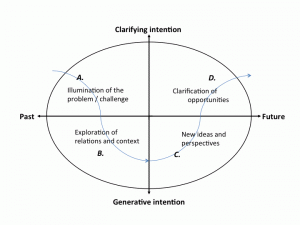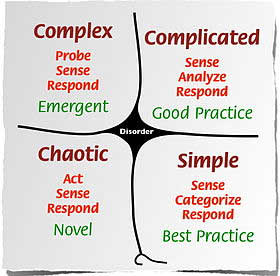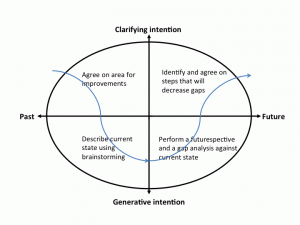I had recently a conversation with a business partner of mine, Erik Andrén at Macmann Berg. We were working on the material for the next workshop in a leadership program we have at a client. This time the workshop was about coaching, both in general terms but also from an agile perspective. Erik has a background as a therapist but is nowadays working as an organization and management consultant. At our meeting he described his view about coaching based on a therapy model he had used as a therapist, and we then had a very interesting discussion about the model and the connection to continuous improvement of teams and organizations. This post discuss this connection since I believe we have a lot to learn from how therapists approaches patients when trying to help them create a better life for themselves.
Coaching model
There are a lot of different theories and models used in coaching as well as in therapy. The one I will show here is just one of them. Therapy has been a lot about focusing on problems and finding root causes of them, but in the later years there have been a change to focus on what can be changed instead; what you can do to move to a desired future. The therapy model shown at the picture below focus on visualizing the desired state and then helps the patient find steps towards that state. There is no digging down on the root causes, instead just start to change by doing.
This model has four main steps/conversations:
- The first one is about framing the problem, setting the context and describing it so that there is an agreement of what it is that you would like to change
- The second one is to expand the perspective, to see the problem from several different angels and perspectives so that you get a better understanding of it
- The third step is to describe and visualize the desired state, who you would like to have it if you didn’t experienced the problem
- The last step is to find one of a few steps that moves you towards your desired step.
As can be seen above you do not dig down to root causes, you work on understanding the problem, the context and how it is experienced from many different perspectives. Since you do not seek causes you avoid blame game, both on others and on yourselves. Without judging you describes the current state, the problem as thoroughly as possible. You then move through a desired future state to find something that you can do to get to your dream. The assumption here is that the problem will eventually disappear just because you start to move forward. There are a lot of theories behind this that is beyond this post, but one way to motivate this is that we create our reality every seconds by our thoughts and our actions. By starting to act differently we also start to experience a new reality. Many times your problems existed in a different reality than the one you have created by moving forward.
Another motivation for this assumptions is that most human aspects live in the complex domain, and in the complex domain there are no clear relationships between cause and effect. You are part of a system where the current state is an emergent effect of the system itself, and you can not extract one part and explain that one as the reason for the effect/problem. Erik him-selves worked according to this model when he was a therapist.
I had heard about this perspective of therapy before when I had talked with a friend of mine who is working as a therapist at a health center. He is trained in several different models like CBT but has lately moved more and more to help his clients by getting them to focus on their bodies instead of their mental state. He has experienced better results with this strategy than when he has tried to find causes of their problems. Today he is working closely with physical therapists to let the patients train on how to work physically, to use mindfulness and other techniques to better understand and interpret their bodies and emotions. This to change the patients reality; the focus on their bodies help them move to a more desired future state, and this without really understand what it was in the beginning that accused their problems.
Coaching teams
I have been heavily influenced by Lean techniques like root cause analysis and to work systematically to find problem areas, the causes of them, and then to improve the system by finding mitigators that attacks the root causes. But I have lately started to questioning this model. Product development is a humanistic game and is therefor also in most cases living in the complex domain. I have started to switch focus to work on visualizing the future and to move to it without any concerns of the causes of current problems. I was therefore very excited by the conversation with Erik, some pieces fell on their right places.
I see it as my main focus as a coach to help organizations establish a culture of continuous improvements; to start a continuous journey of moving towards an Agile way of living. The best way to do that is just start moving, to identify small steps that can be taken to move forward. I good focus is to inject energy into the team by using the tension created by the gap between a clear shared understanding of the current and the future states. This is also very much in line with Toyota Kata where you find concrete descriptions on the next target condition, and then start experimenting towards it, continuously monitoring if you are moving in the right direction or not.
The retrospectives are a great engine in an agile transformation and journey, and you can easily organize the retrospectives to use this model. The general structure would be:
- Frame the problem or area for improvements
- Help the participants describe the current state.
- Do a futurespective to visualize and describe the desired state and then examine the current and future state to find gaps
- Examine the gaps and ask yourselves; what can we do right now to take one step to the desired state and decrease the size of the gap?
The second step can be done by using the normal brainstorming exercise where each one writes post-it notes describing the problem from different angels. The participants may then group and work in this material to get a picture on the reality. Another exercise, which helps you to use the whole brain, is to let the team draw a picture visualizing the problem. This will help the team members talk to each other so that they can reach consensus on how to draw the picture.
I believe it is a good investment spending some time during the second step above, to examine the problem from as many perspectives as possible. As people we live in our own bubbles of reality, created by our past experience and expressed by our language, our own mental models of the reality. It is only by talking to each other that we can look into our different mental models and start creating a shared model that everybody sees. By looking at a problem from all participants perspective, we overlap our different mental models. We may also broaden this further by putting on the glasses of other people and groups, for example the stakeholders or the participants families, to try to describe the problem from their perspective. This would even more create an overlapping of each ones mental model so that you start to see the same thing.
If you have described the current an future states throughly and spent some time discussing it to overlap each mental models, then you should quite quickly find a few small steps the group could take to start moving forward. This is really energizing for the team to agree on concrete steps to the just described future dream state.
Summary
I believe that this model is more energizing, that it increase the creativity and pushes the power down to the participants. One common anti-pattern at retrospectives is that the participants only finds problems outside their control; it is someone else that needs to change in order to fix the problems. They are victims of the system and environment. In these cases it is not uncommon that they stop doing retrospectives after a while since they anyway doesn’t improve how they work. If you instead move the focus on their future state, and ask them what they may do today to move in that direction, no matter how small that step is, you are empowering them to take control and responsibility of their own life. You start a positive reinforcing loop of continuously improved conditions and self control, and also, I believe, a happier life for the team members.







Wow, that was an interesting and inspiring writeup. A concrete example might help to understand the topic, if you can share one (maybe hypothetical). I’m keen on experimenting in this direction with my current project team.
One question, though: when trying to identify how to move to the desired state (step 4), wouldn’t team members naturally fall into a mode of root cause analysis and blaming? How do keep them on track to look ahead instead of back in steps 3 and 4 ?
Hi Lars. Thanks for reading my post, and I’m glad that you liked it. Please let me know how it goes for you if you try this out with your team; I’m always eager to learn more about these things 🙂
A previous post of mine (https://blog.crisp.se/2011/12/07/anderslaestadius/improving-the-daily-scrum) describes the outcome from a retrospective I facilitated using this structure. The team needed to improve their daily scrum meetings and I let them go through the steps described in this post. They first described the current state by individual brainstorming and after that grouping and modeling the current state. With a common view of how their daily scrum worked, they had a new brainstorming session where everybody described how they would like to have the daily scrum meetings. They did this from both process and feelings perspective. This to capture both how they conducted the meetings but also how they felt for each one of them. The last step was to identify the changes, which I describe more in the post linked above.
I hope this helps you and that it clears some of your questions. Otherwise, let me know and I will try to clarify this later.
Regards,
Anders